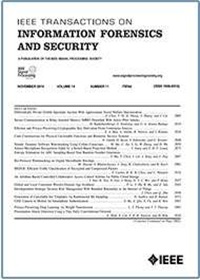From Σ-Protocol-Based Signatures to Ring Signatures: General Construction and Applications
IF 6.3
1区 计算机科学
Q1 COMPUTER SCIENCE, THEORY & METHODS
IEEE Transactions on Information Forensics and Security
Pub Date : 2025-03-17
DOI:10.1109/TIFS.2025.3552199
引用次数: 0
Abstract
Public Key Infrastructure (PKI) has gained widespread attention for ensuring the security and integrity of data communication. While existing PKI mainly supports digital signatures, it is lacking in crucial anonymity, leading to the leakage of a signer’s identity information. To alleviate the issue, ring signatures are a suitable choice to provide anonymity as they allow users to create their own rings without the need for an administrator. Unfortunately, the utilization of ring signatures in PKI may present compatibility challenges within the system. Thus, proposing a general mechanism to convert a standardized从基于Σ协议的签名到环形签名:一般构造和应用
公钥基础设施(Public Key Infrastructure, PKI)因其保证数据通信的安全性和完整性而受到广泛关注。现有的PKI主要支持数字签名,但缺乏关键的匿名性,导致签名者身份信息的泄露。为了缓解这个问题,环签名是提供匿名性的合适选择,因为它允许用户在不需要管理员的情况下创建自己的环。不幸的是,在PKI中使用环签名可能会带来系统内的兼容性挑战。因此,提出一种通用机制,将基于$\Sigma $的标准化签名转换为环签名是具有深远意义的。在本文中,我们提出了将基于$\Sigma $的签名转换为环签名的一般构造。为了实现这一点,我们首先引入了一个基于$\Sigma $的通用模型,提供了一个将现有的基于$\Sigma $的签名转换为$\Sigma $协议形式的通用转换。随后,我们将重新设计的一对多关系纳入我们的一般模型中,并继续设计利用一对多证明的环签名。此外,为了减小签名大小,我们采用了防弹折叠技术,使对数大小的环签名得以实现。为了证明我们的一般结构的广泛适用性,我们提出了四个突出的签名作为案例研究。最后,我们进行了严格的安全性分析和基准实验评估。与其他先进方案相比,签名和验证次数分别为0.44 ~ 0.97次和0.27 ~ 0.91次。此外,我们展示了迄今为止最小的签名尺寸。
本文章由计算机程序翻译,如有差异,请以英文原文为准。
求助全文
约1分钟内获得全文
求助全文
来源期刊

IEEE Transactions on Information Forensics and Security
工程技术-工程:电子与电气
CiteScore
14.40
自引率
7.40%
发文量
234
审稿时长
6.5 months
期刊介绍:
The IEEE Transactions on Information Forensics and Security covers the sciences, technologies, and applications relating to information forensics, information security, biometrics, surveillance and systems applications that incorporate these features
 求助内容:
求助内容: 应助结果提醒方式:
应助结果提醒方式:


